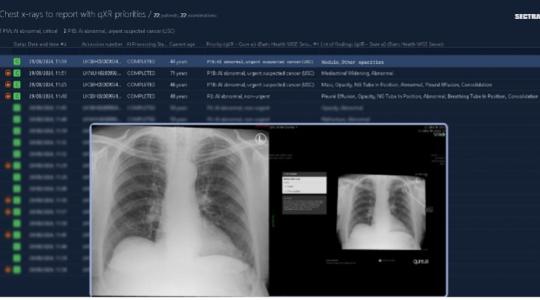North East London Cancer Alliance Shortlisted for HSJ Digital Award
Facing a cancer diagnosis is hard enough. Understanding treatment options, navigating the health system, and giving informed consent should not add to the burden – but for many patients, particularly those with limited English or lower health literacy, it does.
That’s why North East London Cancer Alliance has pioneered a project, led by Barts Health clinicians Adam Januszewski and Elizabeth Nally; to produce unique, clinical animations which are designed to make complex medical information clear, inclusive, and accessible for all.
These multilingual clinical animations are already empowering patients to understand their treatment options, engage in informed decision-making, and navigate their care with confidence.
The animations have been rolled out across all three trusts in north east London - Barts Health NHS Trust, Barking, Havering, and Redbridge University Hospitals NHS Trust (BHRUT), and Homerton Healthcare NHS Foundation Trust.
Focused on underserved communities, the animations remove barriers such as language and health literacy, ensuring inclusivity and equity in access to systemic anti-cancer therapies and clinical trials.
And on Thursday 26 June at the ICC in Birmingham, this work was recognised nationally when the project was shortlisted at the 2025 HSJ Digital Awards, a celebration of excellence in harnessing digital to improve patient care.
“These animations are about more than just information – they’re about equity, empowerment, and giving every patient the chance to understand and own their care journey,” said Oliver Hawkins, Programme Manager at North East London Cancer Alliance.
Cancer patients in north east London – one of the most diverse areas of the country – face significant barriers to understanding their care. Around 43% of UK adults struggle with health information, and patients from ethnic minority backgrounds are statistically less likely to be informed about or participate in clinical trials. In north east London, over a quarter of the population speak a language other than English at home.
Clinicians noted that verbal explanations, written leaflets, and appointment letters weren’t enough, especially for patients where English is not their first language or where medical literacy is low.
This led to a vital question: How can we make sure every cancer patient truly understands what lies ahead, and feels confident about the decisions they make?
The Solution
The Cancer Alliance teamed up with animation specialists Explain My Procedure (EMP), clinicians from Barts Health to lead this across the cancer pathway, and a broad network of patients and public representatives to co-create a suite of short, visual animations explaining cancer treatments and trial access.
The animations are:
- Short and focused, using plain, easy-to-understand language
- Visually rich, with diverse characters and inclusive illustrations
- Narrated and available in multiple languages
- Optimised for easy sharing via QR codes, emails, or NHS platforms
- Designed to support conversations, not replace them
Topics covered include:
- What to expect after a cancer diagnosis
- How chemotherapy and radiotherapy work
- What a clinical trial is, and how to get involved
- Understanding of the side effects of treatment
Co-Design in action
Patient representatives were deeply involved from the beginning, shaping the tone, content, and visuals, reviewing the resources for clarity and literacy.
Clinicians, nurses, and cancer pathway leads ensured clinical accuracy while keeping the information accessible and compassionate. Language specialists and equality experts reviewed the content for cultural relevance.
The partnership with EMP was essential in creating animations that simplified complex information without comprising accuracy. The use of bilingual medically trained professionals, rather than AI, in the translation process ensured linguistic and cultural accuracy while supporting the goals of equality and inclusivity.
Translations currently include Bengali, Polish, Turkish, Hindi and English. Additional translations in Tamil, Gujarati, Urdu and Panjabi are planned, helping to reach north east London’s diverse populations.
Reach and results
Evidence of performance against the project’s success measures has demonstrated its impact on patient engagement and understanding. Pre- and post-implementation surveys revealed increased patient confidence in discussing treatment options and a higher rate of informed decision-making during consultations.
The multilingual nature of the animations addressed language barriers, providing patients with clear, accessible information about their care.
Additionally, clinical teams reported improved consultation efficiency, with less time spent on basic explanations, allowing for deeper, more meaningful discussions about patient care.
Overall outcomes so far include:
- Improved understanding and recall of treatment options
- Better uptake and engagement with clinical trials
- Reduction in follow-up queries, saving staff time
- Positive patient feedback, especially from non-English-speaking groups
Recognition and awards
At the HSJ Digital Awards, the judges recognised the project for:
- Its innovative use of animation in clinical communication
- Its success in addressing health inequalities
- The scale and ambition of its co-design process
- Its potential to be replicated across the NHS
Though the team didn’t take home the trophy, the shortlisting marked a significant milestone for digital inclusion in cancer care.
Adam Januszewski, Medical Oncologist at Barts Health said “It’s a shame we didn’t win but the impact this is having on patients in clinic is showing. We are putting patients in control and removing the barriers written words often take”.
Wayne Douglas, Programme Lead commented, “We’re dedicated to expanding this initiative – developing more animations, reaching wider audiences, and making digital health communication truly accessible. We’ve also started a new project aimed at improving patient awareness when they are referred onto the cancer pathway. There’s much more to come.”
What’s next?
The Cancer Alliance is already planning next steps:
- Expanding the animation library to cover more cancer types
- Increasing the number of available languages
- Evaluating the animations’ impact on outcomes like consent, adherence, and experience
There is also growing interest from other ICSs and Trusts in adopting the model.
A model for inclusive digital care
This project shows that innovation doesn’t have to mean complex technology or high costs – it can mean listening, simplifying, and rethinking how we communicate. By putting patients at the heart of the solution, North East London Cancer Alliance has created something that resonates deeply, not just with patients, but with healthcare professionals too.
And the HSJ Digital Awards have shown the nation what’s possible when inclusivity, design, and digital thinking come together for better care.
For more information
To find out more about innovation in diagnosis and treatment, watch our video: https://youtu.be/urpQ6-AnExc






